| The Borough Council
and its works
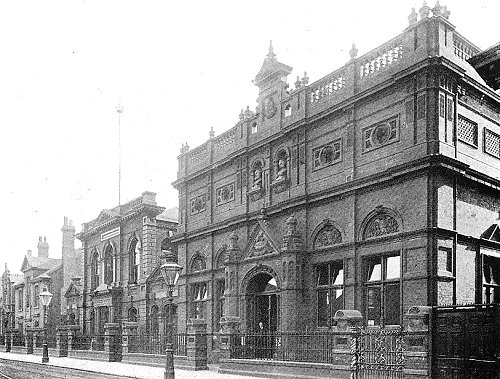
The Town Hall and Art Gallery.
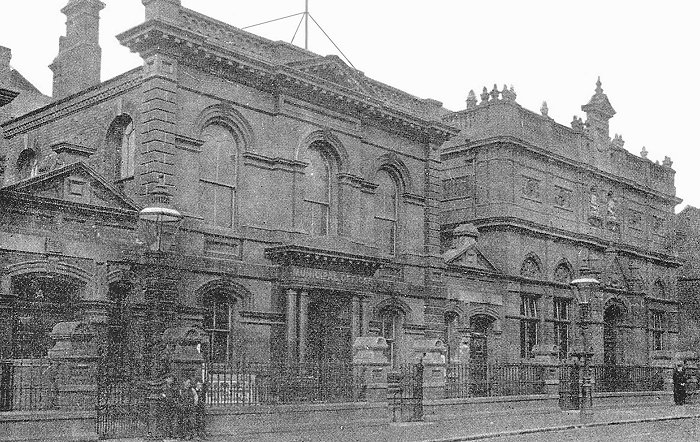
Another view of the Town Hall and
Art Gallery.
The town became a Municipal
Borough in 1886 and duly elected its first Borough
Council. The members were as follows:
|
Aldermen: |
| Richard Williams - Mayor,
J. H. Walton, Joseph Trow, J. A. Kilvert |
|
Councillors - Market Ward: |
| Edwin Butler, licensed
victualler, Charles Hinton, butcher |
| J. G. Thursfield, solicitor |
|
Town Hall Ward: |
| Jamess Davies, engineer,
Dr. McKenna, G.P. |
| William Perry, roll turner |
|
King's Hill Ward: |
| G. P. Butler, gentleman,
Austin Clews, baker |
| Samuel Sanders, lockmaker |
|
Wood Green Ward: |
| Isaac Griffirhs, tube
manufacturer, Isaiah Oldbury, coach
axle manufacturer |
| A. E. Pritchard, tube
manufacturer |
The first officers appointed by the Council were as
follows:
| Joseph Smith -
Town Clerk. Salary £150 |
| E. C. Richardson -
Treasurer. Unpaid |
| E. M. Scott -
Borough Surveyor. Salary £200 |
| James Campbell -
Rate Collector. Salary £150 |
| Dr. Walter Garman
- Medical Officer. Salary £84 |
| W. H. Coney -
Inspector of Nuisances and Market Inspector.
Salary £100 |
| 2 Police Sergeants
- Inspectors of Dairies, Cowsheds and
Milkshops. Joint salary £10 |
Four important buildings appeared in
the later part of the 19th century. The new police
station was built in Holyhead Road to replace the
old Russell Street building. The Post Office on
Holyhead Road was built by the government and opened
in March 1883. The Volunteer Drill Hall opened in
Bridge Street in 1893, and the Nurses Institute in
Wood Green Road opened in 1897 to commemorate Queen
Victoria's Diamond Jubilee.
 |
The Drill Hall
in 1908. |
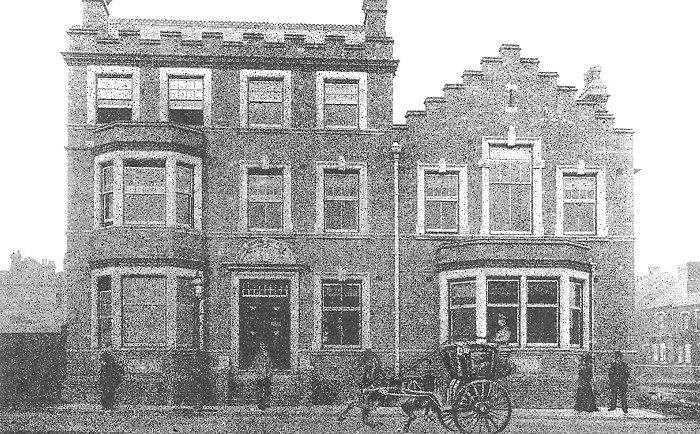
The Conservative Club in its
early years.
|
| Another new building that appeared at the end of the
nineteenth century was the fire station at the High
Bullen. It opened in 1899. At the time, Wednesbury
Fire Brigade was a voluntary organisation. Anyone
reporting a fire had to telephone the police station.
Often when a fire was reported, no horse would be
available, and so it could be a difficult and lengthy
process to get to a fire. |
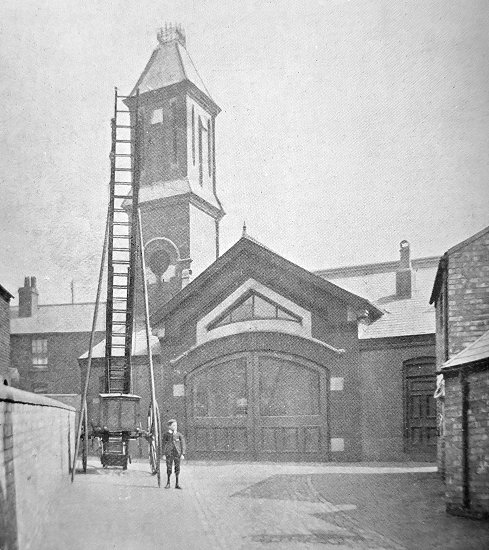
The new fire station. |
| William Potter, a
Wednesbury Coal Jagger. |
|

William Potter at the bottom of Russell
Street.
Known by sight to most Wednesbury people was
William Potter, of Holloway Bank, who died in
February 1907, at the age of seventy nine. He
was a "coal jagger," supplying his customers in
small quantities straight from the pit mouth.
His horse attached to three small trucks,
each with three wheels, and coupled together,
was the old man's peculiar method of "drawing."
These separate loads doubtless found quicker
sales among small consumers. This is the only
excuse for such an outrage on the mechanical
principles of draught, which forced the horse to
overcome the friction of nine wheels instead of
about two. From the 1908
edition of "Ryder's Annual". |
|
Mr. Job Poxon and his Tricycle |
|
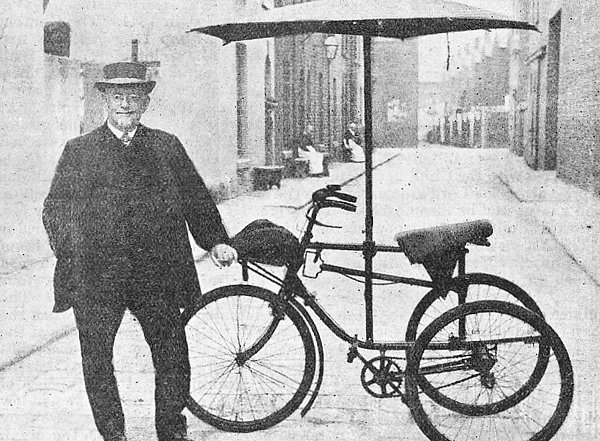
Mr. Job Poxon, a well known
Wednesbury man, though now living in Blackpool,
has solved the problem of eternal rain, moved
thereto by the experience of last summer, and
the way to combat it. He is an ardent cyclist
and has constructed an umbrella for his tricycle
which enables him to defy the elements.
From the 1913 edition of
"Ryder's Annual". |
|
Sanitation and HealthOne of the council's early considerations was
sanitation. The town was not immune from infectious
diseases. In 1889 there were 28 cases of diphtheria, 154
cases of scarlet fever, and 42 cases of typhoid. Some of
the living conditions in the town were extremely
primitive and many houses lacked a drain to connect them
to a sewer. Some of the worst slums were condemned and
demolished, such as the ones in Beggars Row, which were
removed in 1891, and 30 cottages in Elwell's Square at
Wood Green, demolished in 1897. Drains were eventually
laid and the number of water closets finally outnumbered
the antiquated ash privies by 1915. It also took a long time before the town had an
adequate domestic water supply. It took until 1943 for
all of the town's houses to have piped water, but even
then, some houses still had a shared supply.
10 stand pipes and 78 washhouse taps were shared by
200 houses at the time and in 1955 there were still 178
houses sharing taps. |
|
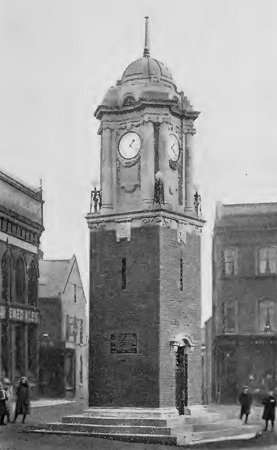
The clock tower in the market
place. |
One of the council's success stories took place at
the sewage disposal works at Bescot. In 1910 a new
method of bacteriological purification had greatly
improved the old method of chemical precipitation. As a
result visitors came from far afield to view the new and
improved process and an expert from Russia declared the
works to be "the very best that exist". From the
beginning of the council and the appointment of its
first medical officer, there were frequent discussions
about the building of an isolation hospital. Nothing
happened however, until the outbreak of smallpox in the
town during 1898 when 8 cases were reported. As a result
an isolation hospital opened the following year in
Dangerfield Lane with 28 beds.
Only one disease at a
time could be treated and the hospital was only used
intermittently. From 1909 to 1913 there were only 16
patients and so it was inevitable that the hospital
would eventually close. Arrangements were made to make
anyone living in Wednesbury and suffering from an
infectious disease other than smallpox, eligible for
admission to the West Bromwich Isolation Hospital. In 1929 Wednesbury became a member of the South
Staffordshire Joint Smallpox Hospital Board which meant
that any smallpox sufferers in Wednesbury were eligible
for admission to Moxley Isolation Hospital. As a result the hospital in Dangerfield Lane closed
and the building was temporarily used for housing
accommodation. |
| The Art Gallery
Local industrialist Edwin Richards was passionate about
art and had a collection of over 300 paintings. His
widow, Mary died in 1885, and left the collection to the
town.
Most of the paintings were by contemporary English
artists, but because of his love of landscape paintings
there were several by Dutch and Flemish masters. |
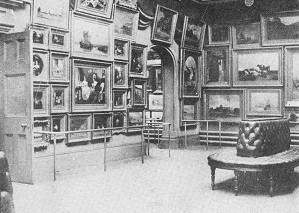
The Richards Room in the Art
Gallery. |

A wide-angle view of the Richards Room, as
seen in 1908.
|

Another view of the Richards Room.
|
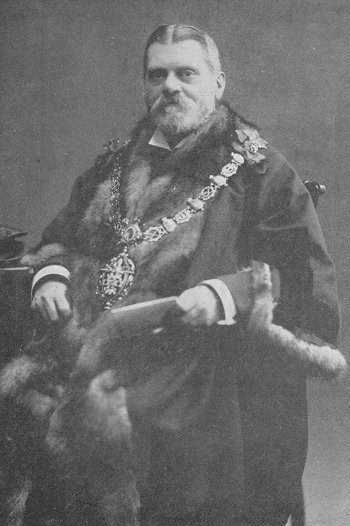 |
|
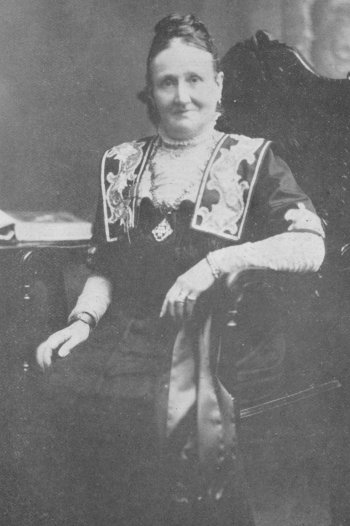 |
|
The Mayor in 1909, Councillor I.
Griffiths. |
|
The Mayoress in 1909, Mrs. I. Griffiths. |
|
|
The Mayor and
Mayoress of Wednesbury. From the 1909 Ryder's
Annual.
The election of Councillor I.
Griffiths, J.P., to the Mayoralty of his native town
gave great satisfaction in all circles of the
community. To his colleagues on the Council it was a
pleasing duty deferred much longer than they would
have willed, for it is known that Councillor I.
Griffiths has been approached in several previous
years, but has not until now been found willing to
assume the dignity and take on the duties of the
Mayoral office. Even now he would have been quite
agreeable to continue his good work for the town in
the position he has so long occupied; but, yielding
to a sense of duty, he has accepted the high office
of Mayor and Chief Magistrate, and that he will fill
it with distinction is assured.
Councillor Griffiths is a
native of Wednesbury, born in 1840, and the present
head of one of our oldest families, his ancestors
having belonged to the town for many generations
past. He is the eldest son of the late Mr. Isaac
Griffiths, who was in the service of the Russell
family before the invention of gas tubes, and was
connected with them altogether for more than forty
years. This gentleman commenced tube-making on his
own account in 1860, and a successful business was
built up, our Mayor being connected with it from the
start.
For many years past the
Imperial Tube Works, New Town, have been in the
capable hands of Councillor Griffiths and his
brother. In 1867 Councillor Griffiths married a
daughter of Mr. Thomas Hawkins, of Walsall, and of
the Delves Green Farm, who besides fulfilling her
domestic duties has shared her husband’s public work
and busied herself in the realms of religion,
philanthropy, and politics. She is thus admirably
qualified for the carrying out of all those
obligations which fall to the lot of a Mayoress.
They have a grown-up family of seven sons and
daughters.
Councillor Griffiths was 34
years of age when he commenced his public life, his
first election being to the old School Board, on
which he served for twenty years. He was elected one
of the first members of the Education Committee, on
which the Mayoress is also a co-opted member, and he
is Chairman of the Higher Education Committee. Since
Wednesbury was incorporated in 1886 Councillor
Griffiths has sat continuously for Wood Green Ward
and only on one occasion has he had to contest the
seat.
As Chairman of the right and
Water Committee he has long occupied a very
responsible position, and in connection with the
introduction of our own system of electricity,
Councillor Griffiths has shown great grasp of
detail, and is working very hard to place it on a
successful footing. Councillor Griffiths initiated
the Wednesbury Football Charity Association in 1880,
raising £100 by subscriptions to purchase the
challenge cup, and he has been president ever since.
By its means large sums of money have been raised
and given annually to hospitals and other charities,
particularly to the Wednesbury Indigent Sick
Society, Nurses' Home, and the Poor Children's
Clothing Fund, in connection with the Education
Committee, which almost depends upon it for its
funds. Councillor Griffiths takes a very deep
interest in religious and philanthropic matters. For
nearly 29 years he has been churchwarden at St.
Paul's, being first people's and now Vicar's warden.
When the town was granted a commission of the peace
in 1893 he was enrolled one of the justices, and has
been a regular occupant of the magisterial bench
ever since, showing at all times a keen insight and
a judicial mind. In politics Councillor Griffiths
remains a Liberal, but he has not for many years
taken the leading part in the councils of the party
which he was wont to do. One of his principal
relaxations is travel, and his home at the "Hollies"
contains many reminiscences of happy holidays in
highways and byeways not only in all parts of the
British Isles but in Holland, Belgium, France,
Germany, Italy, Switzerland, and Norway. The first
important duty which has fallen to the Mayor and
Mayoress is in connection with the relief of
distress caused by unemployment, which unfortunately
exists to a great extent. They are tackling the work
with a will, and may success attend their efforts. |
|
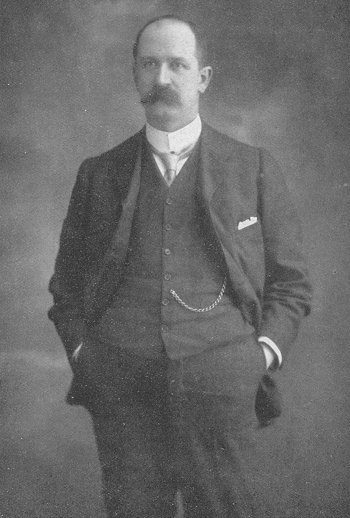
Councillor J. H. G. Davis. |
Councillor J. H. G. Davis. From the 1909 Ryder's
Annual.
Mr. John Henry Grant Davis is
not a native of Wednesbury, but he is a gentleman
whom the town welcomes, as the Mayor remarked at his
first Council meeting, because he takes an active
interest in its industrial welfare.
Councillor Davis is the new
member for Town Hall Ward, having succeeded
unopposed to the seat vacated by Alderman Handley's
elevation. He comes of an old Gloucestershire family
who for many years were farmers near Stroud. In 1836
his grandfather and father migrated to Leeds, and
carried on business as Indigo Blue and Scarlet
Dyers. In 1867 his father and brother bought the
dyeworks at Greetland and carried on business there
until 1887 when, on the death of Mr. Davis, senior,
the subject of our sketch joined his brother in the
business. On the death, in 1893 of his brother, Mr.
J. W. Davis (who was Alderman of the Borough of
Halifax and three times Mayor), Councillor Davis
retired from business for a time and went to reside
in the South of England.
In 1901 he bought the business
of William Trow & Sons, Engineers and Ironfounders,
and settled in Wednesbury. |
| Having now taken up public work he will be
regarded as a very valuable recruit, and we believe
he will make his mark on the Council. He had
previously displayed some interest in polities,
being an ardent Conservative, and on the formation
of the Junior Unionist Association he was elected
President. He is a Churchman and also a Freemason
and is Past Master of the premier Lodge of
Yorkshire, Probity, No. 61. Councillor Davis is the
youngest son of late James Davis, of Bankfield,
Greetland, Yorkshire, and was born at Leeds on
November 1st, 1889. He was educated at Elland and
Halifax. He married in1889 Miss Buckley, of South
Field, Halifax, and has three daughters. |
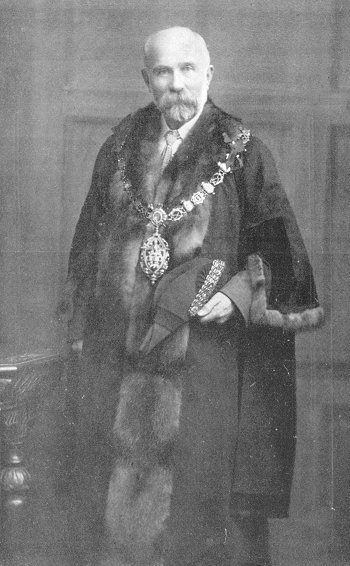 |
|
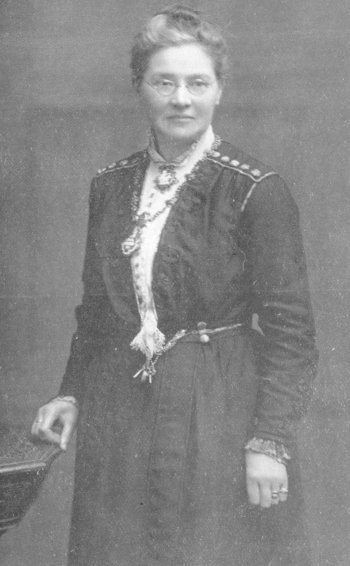 |
|
The Mayor in 1916, Councillor William
Warner. |
|
The Mayoress in 1916, Mrs. W. Warner. |
|
|
The Mayor and
Mayoress of Wednesbury. From the 1916 Ryder's
Annual.
After five years membership
of the Town Council, which he joined as a
representative of Wood Green Ward when
Councillor Griffiths was elevated to the
Aldermanic bench, Councillor Warner now finds
himself, by the unanimous vote of his
colleagues, at the head of the Municipality.
That he will worthily occupy the high position
to which he has been called we do not doubt.
His long business career
has furnished him with the necessary
qualifications, and the fact that he is now
living in retirement indicates that be will have
ample time in which to discharge the manifold
duties of the Mayoralty. Councillor Warner was
born at Simpson, Bucks., on August 14th, 1854,
and came to Wednesbury as
Assistant-superintendent to the Prudential
Assurance Company in 1884. After two years he
was transferred to Hanley, and in 1890 was
appointed Superintendent of
Newcastle-under-Lyme.
In February, 1898, he
returned to Wednesbury as Superintendent, a
position he occupied, with conspicuous success,
until his retirement about two years ago. In
June, 1887, Mr. Warner married into an old
Wednesbury family, his wife being the youngest
daughter of the late Mr. Joseph Slater. We offer
her, on behalf of the burgesses, hearty
congratulations on becoming Mayoress of her
native town. The Mayor and Mayoress have a
daughter and two sons. Councillor Warner is a
Wesleyan, and is attached to Wesley Church,
Holyhead Road, in connection with which he is an
active worker.
He has been a local
preacher for upwards of 35 years. In politics he
is a Liberal. In addition to his municipal work,
Councillor Warner has undertaken important
duties in connection with the Staffordshire
Insurance Committee, in the operations of which
he is keenly interested, and is looked up to by
his fellow members as an expert. We wish the new
Mayor and Mayoress a successful year of office,
trusting they will have health and strength to
carry out the duties, more onerous than usual on
account of the war, and we will pray that it
will be the happy lot of the Mayor to declare,
before the end of 1916, a victorious and lasting
peace. |
|
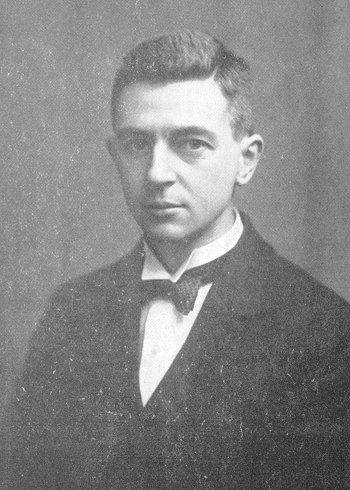
Councillor Shirlaw. |
Councillor Shirlaw.
From the 1916
Ryder's Annual.
Mr. Lewis A. Shirlaw, the youngest member of
Wednesbury Town Council, joined that body on
February 26th, 1915, as a representative of Wood
Green Ward, in which he is resident, when
Councillor E. J. Hunt was chosen to succeed the
late Alderman Handley.
He is the third son of the late Mr. Andrew
Shirlaw and Mrs. Eleanor Shirlaw, eldest
daughter of the late Mr. John Hunt Thursfield,
and was born at Beeches Road, West Bromwich, on
November 6th, 1884. He was articled to Mr. J. G.
Thursfield, and was admitted a solicitor in
December, 1906. After acting for three years as
managing conveyancing clerk to a firm of
solicitors in the West End of London he returned
to Wednesbury, and, shortly afterwards, became a
partner in the firm of Messrs. Thursfield,
Messiter & Shirlaw.
On April 9th, 1912, Mr. Shirlaw married Miss
Marguerite Rutherford Paterson, daughter of the
late Mr. Thomas Paterson and Mrs. Paterson, of
Melrose, N .B. They have one son. Councillor
Shirlaw was recently elected on the Education
Committee in succession to the late Alderman
Griffiths. He is a Conservative and a Churchman. |
|
Councillor Beebee.
From the 1916 Ryder's Annual.
Mr. Alfred Beebee, the
first member of Wednesbury Town Council to be
co-opted, under war legislation, fills the seat
in King's Hill Ward vacated by Councillor Bishop
on his election as Alderman.
Councillor Beebee was born
at Darlaston, in 1873, and was educated at the
Wesleyan Schools. From the time of leaving
school until 1904 he was in the employ of Messrs
F. W. Cotterill, Ltd., under Mr. T. S. Peacock.
He then commenced business
on his own account as a bolt, nut, and
stud manufacturer, with a few hands, and at the
present time has about 140 employees in his
model factory in Wood Street.
In 1901 Mr. Beebee married Miss Fullwood,
youngest daughter of Mr. William Fullwood, of
Darlaston. He is a Conservative in politics and
a member of the Church of England, occupying the
position of sidesman at Darlaston Parish Church. |
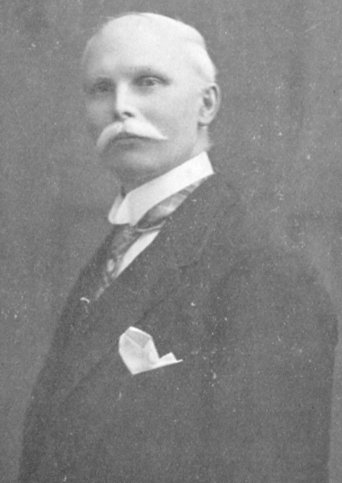
Councillor Beebee. |
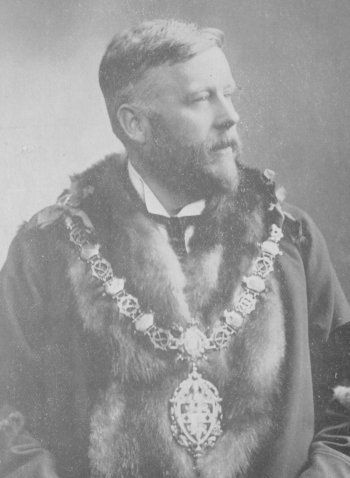 |
|
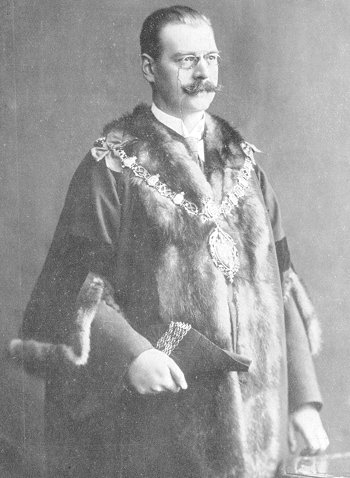 |
|
Alderman Hunt. |
|
Alderman
Bishop. |
|
| Housing The
problem of inadequate housing and also the shortage of
housing continued for many years after the formation of
the Borough Council. In 1913 the council appointed a
sub-committee to look into the alleged shortage of
houses and to report their findings to the Sanitary
Committee at the earliest possible date. It took 12
months for their investigations to be completed, after
which the Sanitary Committee recommended that an
application should be made to the Local Government Board
for a loan of £5,240 for the building of 24 council
houses at Hobs Road, Wood Green. Unfortunately the
application was made at an unfortunate time, the start
of the First World War. It was rejected but 21 houses
were built in 1915 by a private firm.
After the war local councils were offered a subsidy
for each council house built, thanks to the terms of the
Housing and Town Planning Act of 1919. At Wednesbury 250
houses were built at Wood Green, and 108 at Manor Farm.
But there were still many overcrowded houses in the
town, and in 1925 the situation was noted by a
government inspector, who was very critical of the poor
housing conditions in the town. This resulted in
questions being asked in the House of Commons by Alfred
Short, the borough's member of parliament, who came to
Wednesbury and made a scathing attack on the council.
The council took no action to remedy the situation until
1926, and only then because of a tempting government
subsidy, and the lack of private sector building.
|
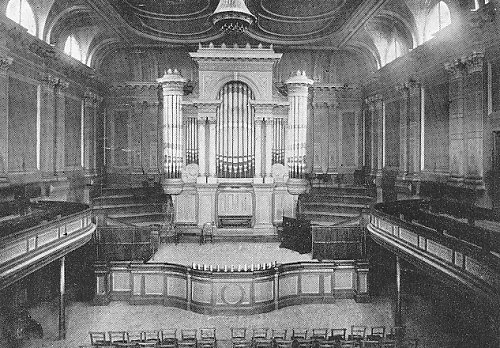
The Town Hall. |
|
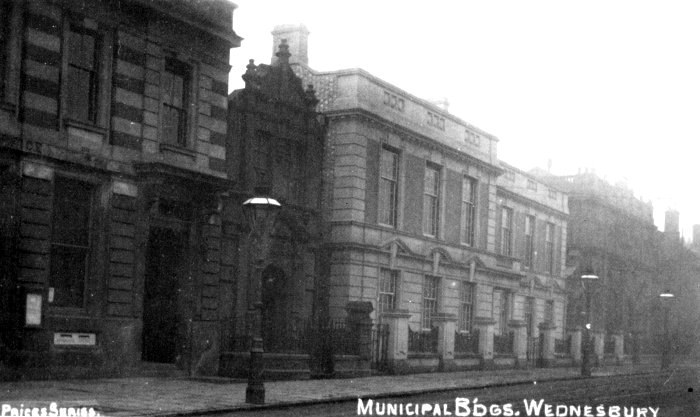
From an old postcard. |
In between 1926 and 1930 a total of 206 council houses
were built at Mesty Croft, 144 houses at Churchfields,
32 on the Holyhead Road, 26 in Wellcroft Street, and 16
in Edward Street. By 1931 1,000 council houses were
occupied, and in 1933 a slum clearance scheme saw the
demolition of old houses in Queen Street, Moxley, Short
Street, and Portway Road. The programme was enlarged and
by 1935 the number of houses that had already been
demolished, or were about to be demolished reached 1,250;
one 6th of all the houses in the town. |
|
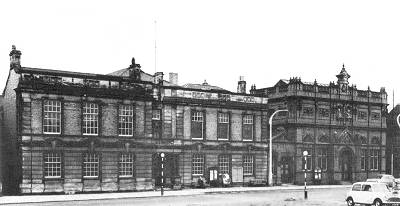
Another view of the Town Hall, as
enlarged in 1913. |
In 1944 there was an immediate need for 700 houses
and so reclamation work began at Park Lane and Hobs Road,
and a plan was put forward to build 1,420 council houses
on 6 sites.
At the time the total number of inhabited houses in
town had reached 8,409, of which 3,088 were council
properties. |
|
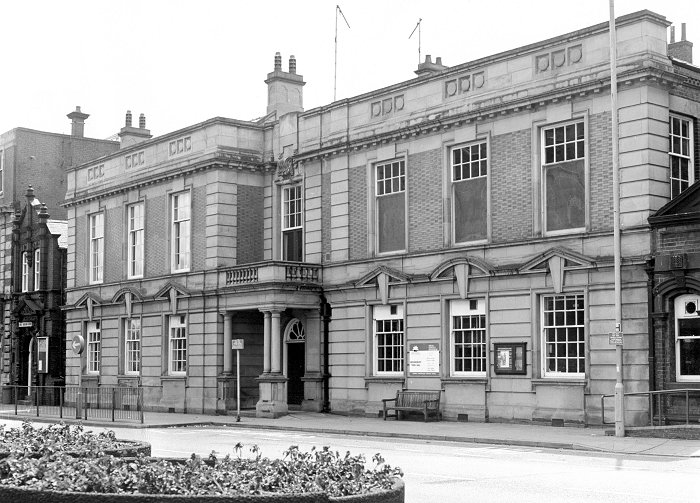
The Town Hall. Courtesy of Brian
Groves and John Hellend. |
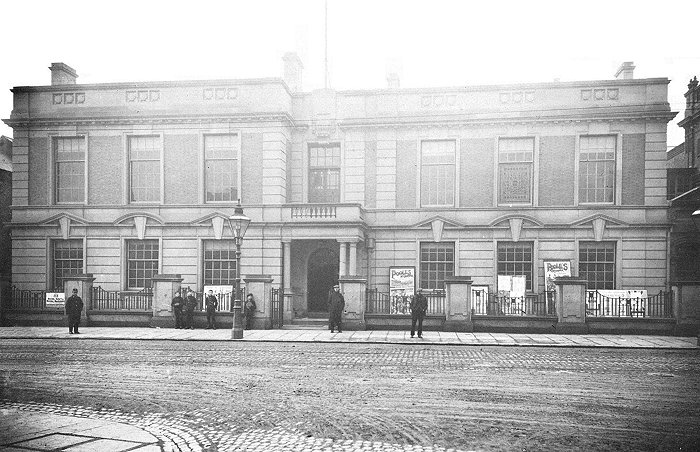
Another view of the Town Hall.
|

The Public Library, Walsall
Road. Courtesy of Brian
Groves and John Hellend. |
|
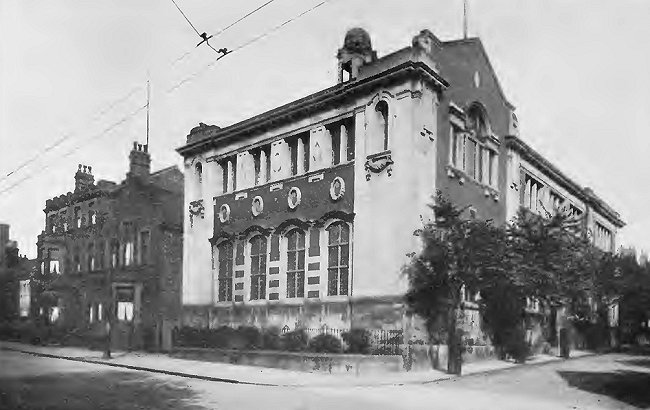
Another view of the library, from
the 1918 Wednesbury Official Handbook. |
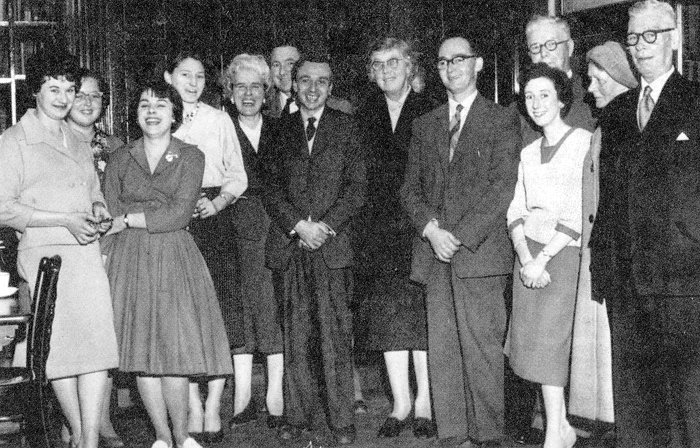
The library staff in 1960.
Left to right; Kath Talbot, Rosemary Wilkes,
Margaret Marshall, Pat O'Neill, Gertrude Jackson,
Mr. Newman (librarian), Elizabeth Hammond,
Councillor Owen, Jean Moseley, Mr. Walford, Mrs. and
Mr. Cresswell. |
| Post war council housing estates are found at
Park Lane, Old Park Road, Dingley Road, Crew Road, Friar
Park, the Golf Course, Millfields, Dangerfield Lane
(Lodge Holes), Mesty Croft, Cross Street and Balls Hill.
Between the end of the war and December 1958 nearly
2,000 council houses were built, and in April 1959 the
5,000th council house had been completed. Over 2,800
houses and old age pensioner bungalows have been
completed since 1945. Electricity
In November 1889 the council decided to apply for an
order for permission to supply the borough's
electricity. Nothing was done until 1898 when the newly
formed Midland Electric Corporation began its
activities. The MEC were formed in June 1897 and became
the first company to distribute electricity over a large
area of the Midlands from their power station at Ocker
Hill.
|
| Wednesbury Council entered into an agreement with
the Midland Power Company in which the MPC would provide
the electricity which would be distributed by the
council throughout the town (except King's Hill where
the MPC distributed the power themselves).
Unfortunately the venture proved to be unprofitable for
the council and so they decided to apply for an
application to generate their own electricity. |
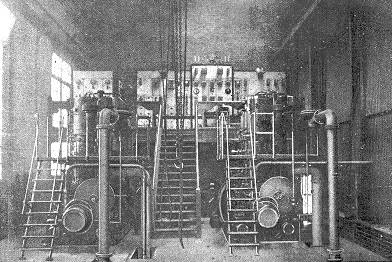
The Council's electricity
generating station. |
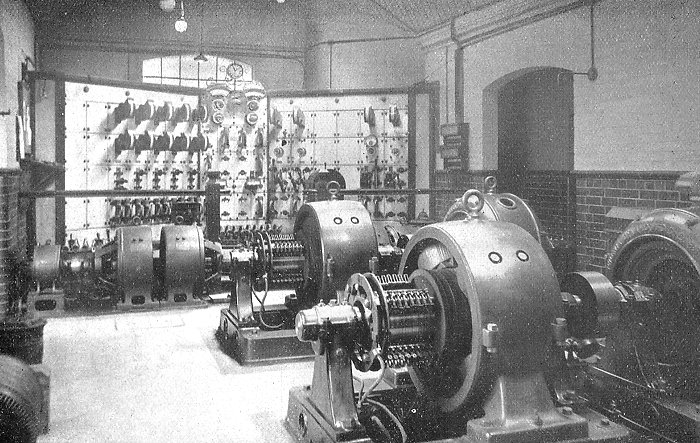
Another view of the electricity generating
station.
|
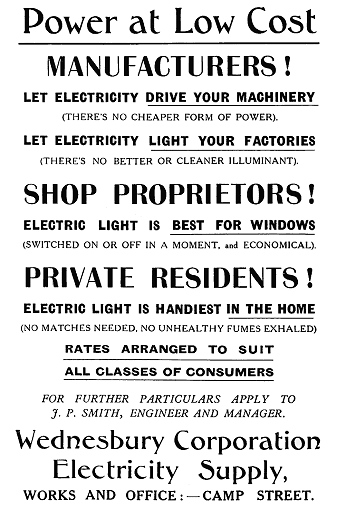
An advert from 1918. |
This was vigorously opposed by the MPC and rejected
by the Local Government Board. In 1909 the council got
their wish and borrowed £10,000 to build an electricity
generating station.
Yet again the venture was not a
success and proved to be unprofitable. Local businesses
complained about delays and breakdowns in the supply
network, and tradesmen were angry because of a steep
rise in the council's charges for electricity.
By 1918
the council had lost £6,000 in the venture and so in
April of that year it sold the entire system to the MEC
for £75,000 to settle its debts. |
|
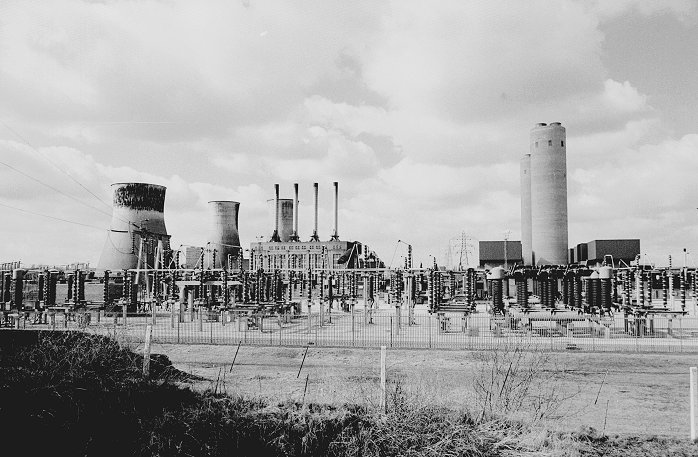
A once familiar sight, Ocker Hill
power station, founded by the MEC. |
|
Brunswick Park Brunswick Park, Wood Green opened to the public in
1887 to commemorate Queen Victoria's Golden Jubilee.
The council purchased 28 acres of land from the
Patent Shaft & Axletree Company, on which to build the
park, which has been a popular attraction ever since it
opened.
|
|

The entrance to the park. |
| The park is built on the site of a former pit mound
and has 20 acres of lawns, shrubs, trees and flower
beds. |

Another view of the park. |
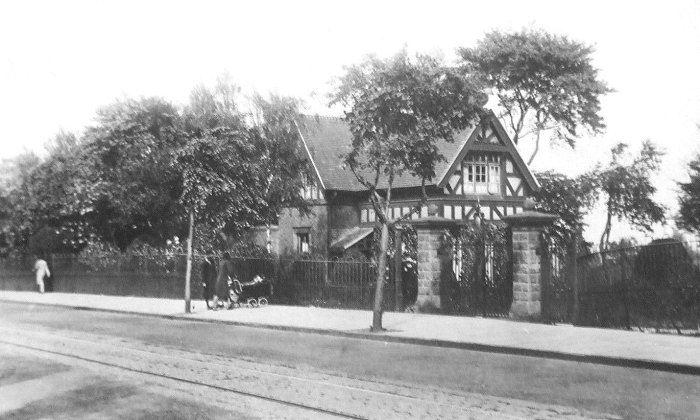
The entrance and the lodge, as seen from
Wood Green Road.
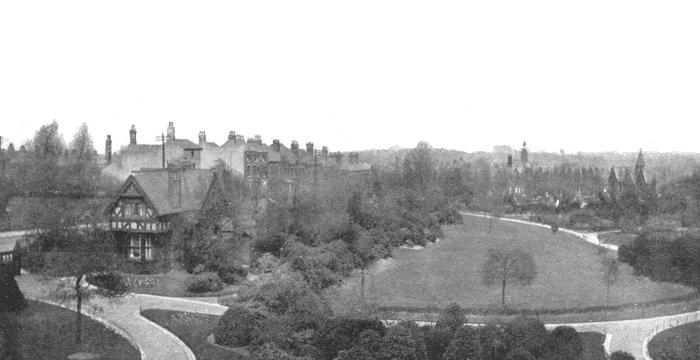
Brunswick Park and the Lodge.
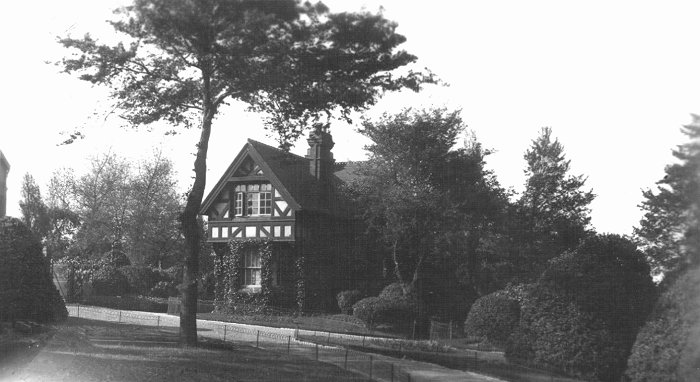
Another view of the lodge. From an old
postcard.
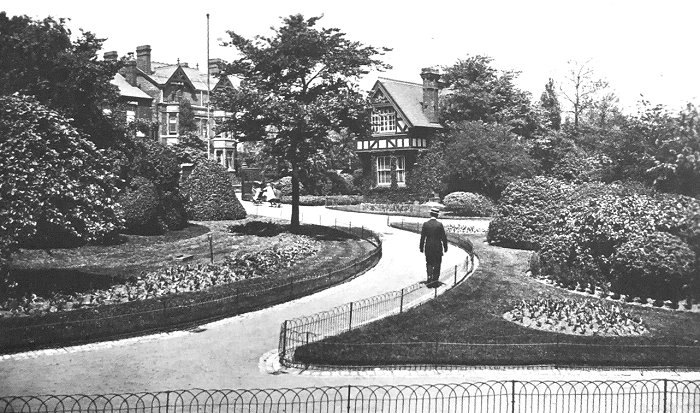
Looking towards the main entrance. From an
old postcard.
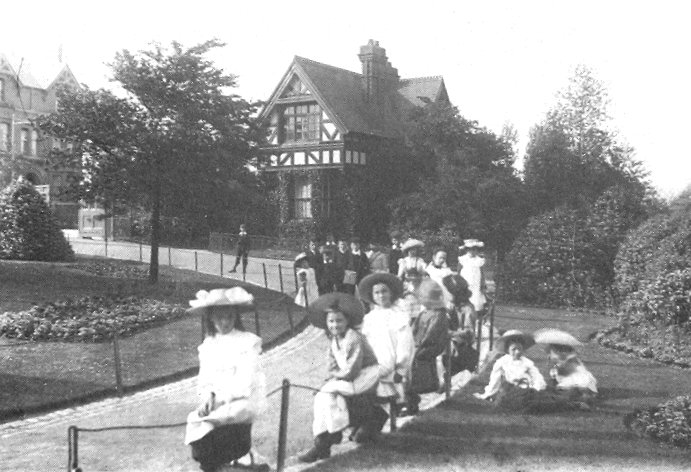
A group of children in 1903, near the main
entrance. From an old postcard.

Another view of the main entrance. From an
old postcard.
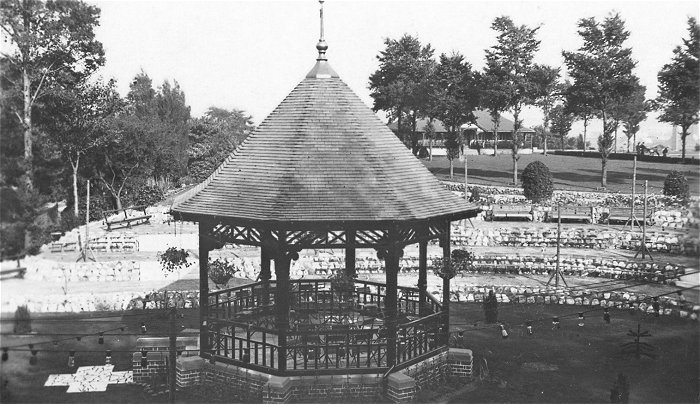
The bandstand. From an old postcard.

Another view of the bandstand. From an old
postcard.
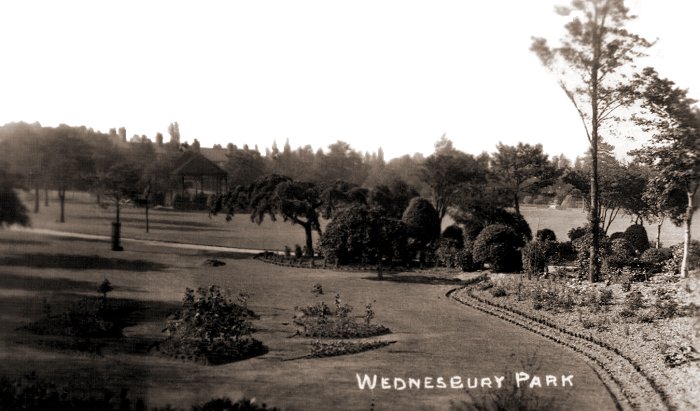
A general view. From an old postcard.
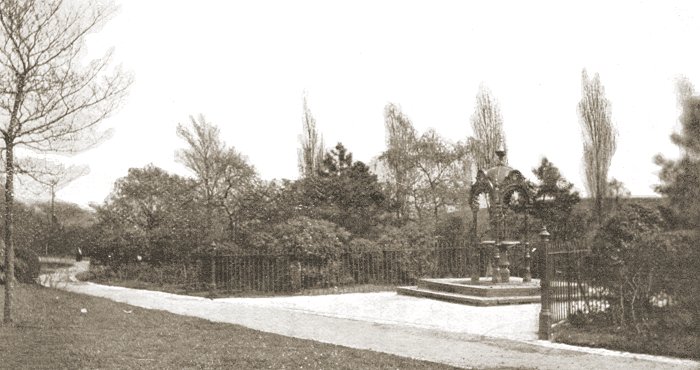
The fountain in Brunswick Park.

Another view of the fountain. From an old
postcard.
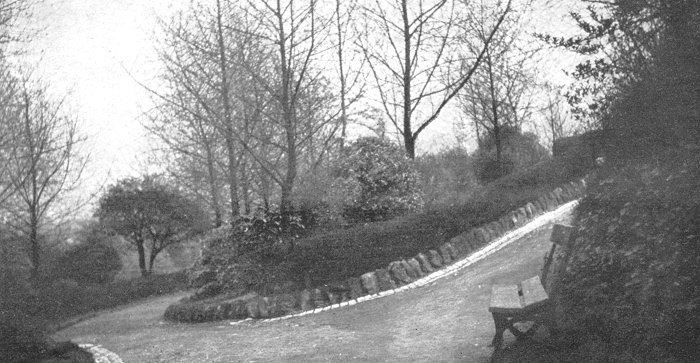
Another corner of the park.
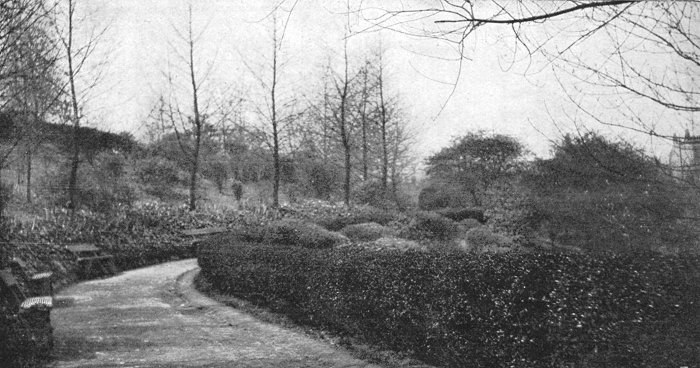
'Invalids' Walk' in Brunswick Park.
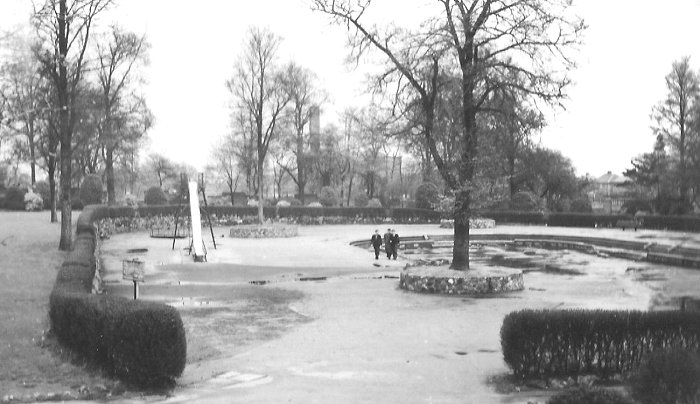
The children's play area. From an old
postcard.
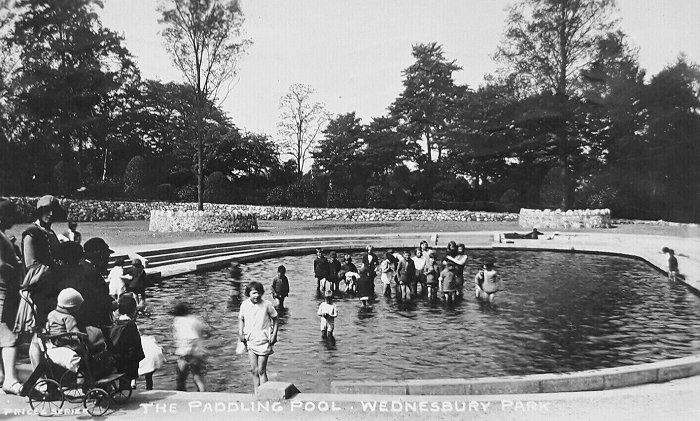
From an old postcard.
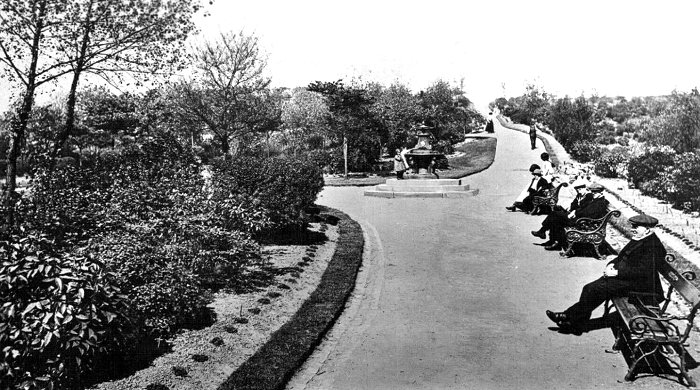
A lovely summer's day in King's Hill Park,
which opened in 1900. From an old postcard.
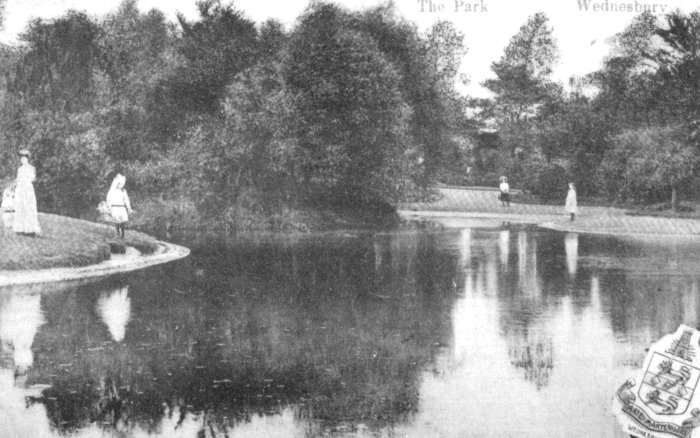
The park lake. From an old postcard.
|
Boundary
Changes and new local government
On 1st April, 1966 under the terms of the Local Government
Reform Act, Wednesbury lost its status as a Municipal
Borough and came under the direct control of West
Bromwich Borough Council, as did Tipton. At the same
time King's Hill became part of Walsall. On 1st April,
1974 Sandwell Metropolitan Borough was formed with the
merger of West Bromwich and Warley Borough Councils. The
new borough includes six Black Country towns: Oldbury,
Rowley Regis, Smethwick, Tipton, Wednesbury, and West Bromwich.
Two of the last acts of Wednesbury Borough Council were
the beginning of the town's ring road in the 1960s and
the start of a scheme to improve the town centre. |
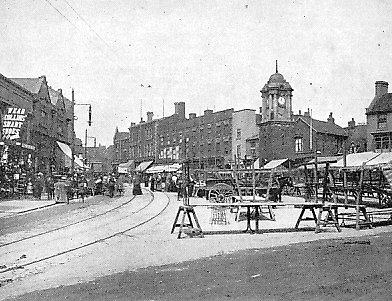
The Market Place in 1914.
 |
|
 |
|
 |
Return to
Education |
|
Return to
the contents |
|
Proceed to Pubs |
|